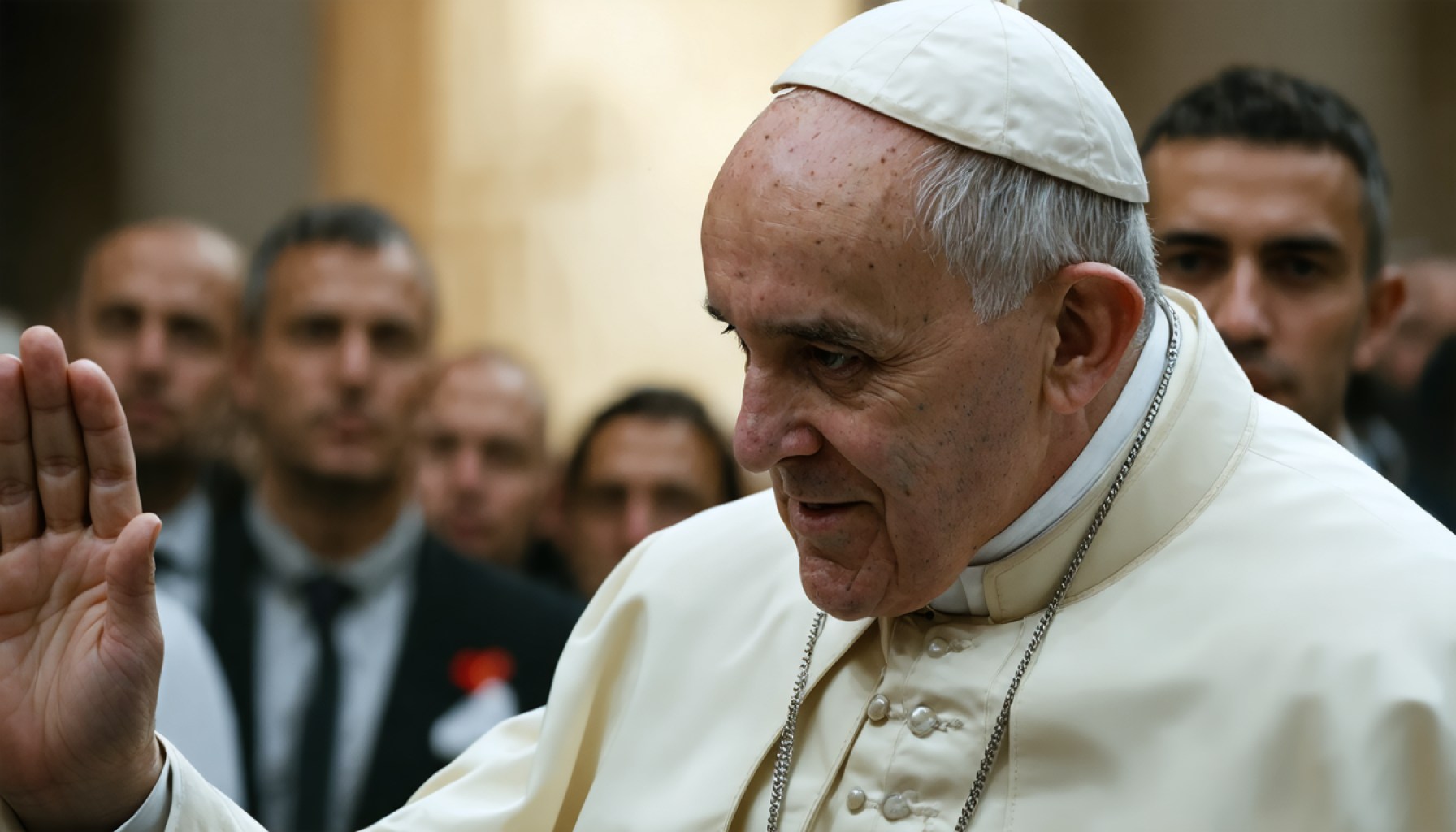- Pope Francis recovers from a critical respiratory crisis at Rome’s Gemelli Polyclinic, expressing gratitude for global support.
- He emphasizes the urgent need for peace, highlighting conflicts in Ukraine, Palestine, Israel, and Myanmar.
- Pope Francis navigates treatment with resilience, relying on high-flow oxygen and support from heartfelt messages during his solitude.
- Children’s messages, filled with hope, significantly uplift his spirit during this challenging time.
- Archbishop Rino Fisichella led a Vatican Mass, encouraging collective prayers for the Pope’s health.
- The Pope highlights that true wellness is nurtured by strong bonds and the pursuit of global peace.
A soft breeze brushed the curtains of the Vatican’s Apostolic Palace, but the sight of Pope Francis waving from the famed window was absent. Instead, a poignant message emerged, rich with the gravitas of his current ordeal. From the confines of Rome’s Gemelli Polyclinic, the leader of the Catholic Church expressed a heartfelt gratitude for global support during his recovery from a critical respiratory crisis.
The Pope’s words, woven with the unmistakable urgency of a world leader, lamented the three-year shadow of war in Ukraine—a disheartening mark on humanity’s conscience. His plea for peace extended beyond borders to Palestine, Israel, Myanmar, and other troubled regions where the cries of conflict echo.
Though bolstered by constant medical attention, the Pope remains in a precarious health state, navigating the rigors of treatment with the quiet resilience he urges upon others. Despite the absence of visitors, the warmth of love and well-wishes envelops him, providing solace amidst the solitude of recovery.
Messages from children, laden with innocence and hope, particularly touched his healing spirit. Meanwhile, high-flow oxygen offers relief in moments of breathlessness, underscoring the delicate balance he maintains between vulnerability and fortitude.
In the heart of the Vatican, Archbishop Rino Fisichella presided over a Mass, symbolizing the collective prayers for the Pope’s health. The diocesan call to spiritual arms was clear: through unity and devotion, the faithful must carry Pope Francis in their hearts as he navigates this period of trial.
As Pope Francis rests and reflects, the message resounds—wellness is not merely physical but grounded in the bonds we forge and the peace we pursue.
Pope Francis’ Health Struggles and Pleas for Global Peace: What It Means for Us Today
The Health of Pope Francis: Insights and Predictions
Pope Francis’ Medical Condition
Pope Francis is recovering from a serious respiratory illness at the Gemelli Polyclinic in Rome. The Vatican has confirmed he is receiving high-flow oxygen therapy, emphasizing his delicate condition but stable recovery trajectory. High-flow oxygen therapy is typically used for severe respiratory crises and helps alleviate breathlessness by ensuring consistent oxygen supply. [Mayo Clinic](https://www.mayoclinic.org) states that such therapy is pivotal in managing acute respiratory distress, providing much-needed relief.
Real-World Implications and Insights
1. Leadership Challenges: Pope Francis’ illness reiterates how vulnerable even global leaders are to health challenges. He manages his duties while recuperating, reminding us of the importance of contingency planning in leadership positions.
2. The Role of Community Support: The global Catholic community’s prayers symbolize the power of collective support in recovery. Community solidarity can significantly impact recovery positively, offering not just physical but emotional strength.
3. Public Figures and Health Transparency: Transparency regarding the Pope’s health highlights how public figures manage health issues. This transparency fosters a supportive environment among followers, encouraging them to engage in health advocacy and emotional support.
Global Peace: Pope Francis’ Call to Action
Pope’s Peace Appeal
Pope Francis’ heartfelt message from his hospital bed emphasized the dire need for peace in conflict-ridden areas like Ukraine, Palestine, Israel, and Myanmar. His appeal encourages world leaders and individuals alike to prioritize peacebuilding and diplomatic dialogue.
How-To Steps for Promoting Peace
1. Engagement in Dialogue: Individuals and communities should foster open communication channels to understand diverse perspectives, essential for conflict resolution.
2. Educating for Peace: Implement educational programs that focus on peace studies, tolerance, and conflict resolution starting at a young age.
3. Supporting Humanitarian Efforts: Engage with and support organizations that provide assistance and advocacy in conflict zones, such as the [Red Cross](https://www.redcross.org).
Markets, Trends, and Future Predictions in Global Peace Efforts
Market Forecasts & Industry Trends
– Rise of Peace-Tech: Innovative technology solutions are emerging to support peace efforts. Platforms that use AI to predict conflict zones or foster virtual mediation are gaining traction.
– Sustainability and Peace: As climate change exacerbates resource-based conflicts, sustainable practices and policies are increasingly recognized as integral to peace efforts.
Future Predictions
– Worldwide efforts toward sustainability and climate resilience will become crucial in the peace process, as natural resource scarcity often underpins or exacerbates conflict.
Reviews & Comparisons: Global Leaders in Peacemaking
Comparative Insights on Leadership and Peace
– The Pope’s active role in advocating for peace is comparable to that of other global leaders like the Dalai Lama or former UN Secretary-General Ban Ki-moon. Each has leveraged their platform to champion peace, therapy and dialogue.
Significant Peace Contributions:
– The Dalai Lama: Advocates for non-violence and compassion, focusing on inner peace as a pathway to global harmony.
– Former UN Secretary-General Ban Ki-moon: Emphasized climate action as tied to global stability and peace, pioneering diplomatic dialogues to mitigate climate-induced conflicts.
Conclusion: What You Can Do Now
– Foster Empathy in Daily Interactions: Cultivate empathy and understand perspectives in daily interactions to contribute to the wider culture of peace.
– Engage with Global Issues: Stay informed about global conflicts and engage in discussions, promoting awareness and advocacy for peace.
– Strengthen Community Bonds: Participate in community and religious gatherings to build solidarity and a shared commitment to peace initiatives.
In summary, Pope Francis’ recent health battles and his global call to peace reflect crucial lessons on leadership resilience, the power of communal support, and the urgent need for peacebuilding efforts. By incorporating these insights into our lives, we can contribute positively to global efforts for harmony and understanding.
